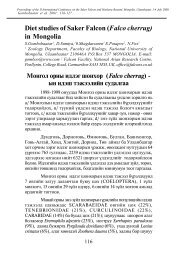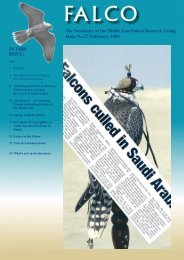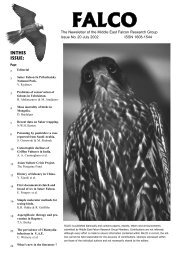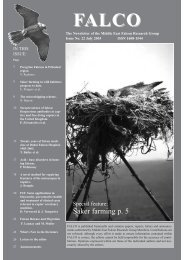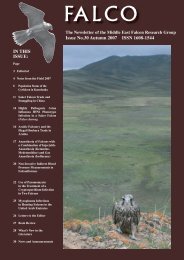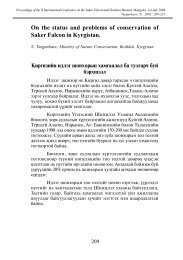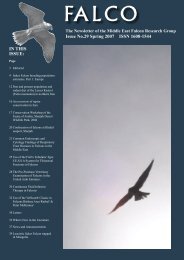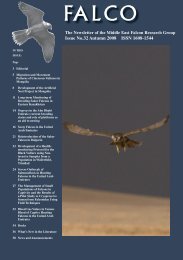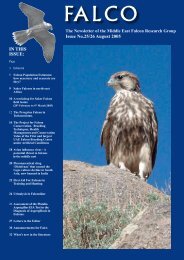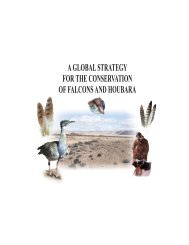Saker Falcon projects - International Wildlife Consultants Ltd.
Saker Falcon projects - International Wildlife Consultants Ltd.
Saker Falcon projects - International Wildlife Consultants Ltd.
You also want an ePaper? Increase the reach of your titles
YUMPU automatically turns print PDFs into web optimized ePapers that Google loves.
<strong>Saker</strong> <strong>Falcon</strong> <strong>projects</strong><br />
currently implemented by<br />
<strong>International</strong> <strong>Wildlife</strong> <strong>Consultants</strong> <strong>Ltd</strong>.<br />
on behalf of the<br />
Environment Agency – Abu Dhabi
MONGOLIA<br />
General Overview<br />
We have been engaged annually in survey and/or research work on <strong>Saker</strong> <strong>Falcon</strong>s in<br />
Mongolia since 1998. Currently, our studies in Mongolia are undertaken under a 5-<br />
year MoU (2010-15) between the Ministry of Nature, Environment & Tourism<br />
(MNET, Mongolia), the Environment Agency-Abu Dhabi (EAD) and <strong>International</strong><br />
<strong>Wildlife</strong> <strong>Consultants</strong> <strong>Ltd</strong> (IWC), and are focussed on (i) developing a long-term<br />
<strong>Saker</strong> <strong>Falcon</strong> conservation programme based on sustainable use and (ii) reducing<br />
electrocution rates at electricity distribution lines. Our research partner in Mongolia<br />
is the <strong>Wildlife</strong> Science and Conservation Center (WSCC). Within the current<br />
research framework we are undertaking the following studies:<br />
Satellite tracking:<br />
Migratory movements of <strong>Saker</strong> <strong>Falcon</strong>s (Falco cherrug) from Mongolia and<br />
adjacent regions of Russia revealed by satellite telemetry<br />
Satellite tracking data of 11 adults and 9 juvenile <strong>Saker</strong>s. Information gained on<br />
migration behaviour (varied from sedentary, short-distance migrants and longdistance<br />
migrants), wintering areas (identified Qinghai-Tibetan Plateau, China as<br />
important wintering area) and migration pathways (direction, speed and use of stopover<br />
sites).<br />
Staff: Dr. Andrew Dixon & Dr. Nick Fox<br />
Participating organisations: IWC; National University of Mongolia; Center of Field<br />
Studies, Nizhniy Novgorod.<br />
Period of project: 1997-2007<br />
Status: Manuscript in preparation.<br />
Post-fledging dispersal behaviour and survival of <strong>Saker</strong> <strong>Falcon</strong>s (Falco cherrug)<br />
from artificial and natural nest sites in the central Mongolian steppe<br />
Based on data obtained from satellite telemetry, radio-tracking and visual<br />
observation of fledglings with patagial tags. Information gained on behaviour<br />
(distance moved from nest, home range size and brood cohesion) and survival<br />
(weekly survival rate) from fledging to dispersal from natal area.<br />
Staff: Dr. Andrew Dixon, Dr. Lutfor Rahman, Gankhuyag Purev-Ochir, Nyambayar<br />
Batbayar, Mark Etheridge
Participating organisations: IWC; WSCC; University of Aberystwyth.<br />
Period of project: 2006-2010<br />
Status: Manuscript in preparation.<br />
Ranging behaviour of breeding <strong>Saker</strong> <strong>Falcon</strong>s (Falco cherrug) at artificial nest sites<br />
in central Mongolia investigated using GPS satellite telemetry<br />
Based data derived from 15 breeding adults fitted with GPS satellite transmitters at<br />
our Artificial Nest Experimental Area in 2009-10. Information gained on variation in<br />
ranging behaviour related to sex, stage of the breeding cycle and prey availability.<br />
Staff: Dr. Andrew Dixon, Dr. Lutfor Rahman, Gankhuyag Purev-Ochir, Nyambayar<br />
Batbayar, Yozora Tadehara<br />
Participating organisations: IWC; WSCC; Boise University.<br />
Period of project: 2009-2010<br />
Status: Data analysis on-going for MSc project based at Boise University, USA.<br />
Post-breeding movements of Mongolian <strong>Saker</strong> <strong>Falcon</strong>s (Falco cherrug) derived<br />
from GPS satellite telemetry<br />
Based data derived from 15 breeding adults fitted with GPS satellite transmitters at<br />
our Artificial Nest Experimental Area in 2009-10. Information gained movements of<br />
breeding birds outside the breeding season.<br />
Staff: Dr. Andrew Dixon, Dr. Lutfor Rahman, Gankhuyag Purev-Ochir, Nyambayar<br />
Batbayar<br />
Participating organisations: IWC; WSCC.<br />
Period of project: 2009-2011<br />
Status: Data analysis on-going.<br />
Movement and habitat use of <strong>Saker</strong> <strong>Falcon</strong>s (Falco cherrug) from the Galba Gobi<br />
Important Bird Area, southern Mongolia<br />
Based on data derived from one breeding adult and two juveniles fitted with GPS<br />
satellite transmitters in the Galba Gobi IBA in 2009. Information gained on habitat<br />
use and movement behaviours of birds in a region subject to mining development.<br />
Staff: Nyambayar Batbayar, Dr. Andrew Dixon, Gankhuyag Purev-Ochir,<br />
Bayarjargal Batsukh, Jonathan Stacey.<br />
Participating organisations: IWC; WSCC; BirdLife <strong>International</strong>.<br />
Period of project: 2009-2011<br />
Status: Data analysis on-going.
Artificial Nests:<br />
The use of artificial nest sites to increase the breeding population of <strong>Saker</strong> <strong>Falcon</strong>s<br />
(Falco cherrug) in nest site limited steppe habitats of Mongolia<br />
Based on data from two Artificial Nest Experimental Areas over the period 2006-11.<br />
Information on occupancy rates (in relation to nest design), breeding density (in<br />
relation to rodent availability), breeding dispersal (nest site fidelity) and nesting<br />
success (Mayfield analysis of incubation and nestling stages).<br />
Staff: Dr. Andrew Dixon, Dr. Lutfor Rahman, Gankhuyag Purev-Ochir, Nyambayar<br />
Batbayar, Mark Etheridge, Dr. Nick Fox<br />
Participating organisations: IWC; WSCC; University of Aberystwyth (UK)<br />
Period of project: 2006-2011<br />
Status: Manuscript in preparation.<br />
Diet and prey availability:<br />
Breeding biology and diet of <strong>Saker</strong> <strong>Falcon</strong>s (Falco cherrug) in Mongolian steppe<br />
habitats with low and high density rodent populations<br />
Based on data from two Artificial Nest Experimental Areas. Information on laying<br />
date, clutch/brood size, nesting success and diet (based on pellet analysis) in relation<br />
to rodent availability.<br />
Staff: Dr. Andrew Dixon, Dr. Lutfor Rahman, Ariunzul Lhagvajav, Gankhuyag<br />
Purev-Ochir, Amarsaikhan Saruul; Nyambayar Batbayar, Mark Etheridge, Nedko<br />
Nedyalkov<br />
Participating organisations: IWC; WSCC; National University of Mongolia; University<br />
of Aberystwyth (UK); Bulgarian Academy of Sciences.<br />
Period of project: 2007-2008<br />
Status: Manuscript in preparation.<br />
Diet of breeding <strong>Saker</strong> <strong>Falcon</strong>s (Falco cherrug) in relation to temporal and spatial<br />
variation in prey availability in the central Mongolian steppe<br />
Based on data obtained from Artificial Nest Experimental Area over the period 2007-<br />
12 (temporal variation in prey availability & diet) and from 20 grids of artificial nests<br />
over the period 2011-12 (spatial variation in prey availability & diet). Prey
availability assessed by means of transect counts and diet assessed from pellet<br />
analysis.<br />
Staff: Dr. Andrew Dixon, Dr. Lutfor Rahman, Ariunzul Lhagvajav, Gankhuyag<br />
Purev-Ochir, Amarsaikhan Saruul; Amarkhuu Gungaa, Batbayar Galtbalt,<br />
Nyambayar Batbayar<br />
Participating organisations: IWC; WSCC; National University of Mongolia<br />
Period of project: 2007-2012<br />
Status: On-going as part of an MSc project based at the National University of<br />
Mongolia.<br />
<strong>Saker</strong> <strong>Falcon</strong> (Falco cherrug) feeding behaviour during the nestling period in the<br />
central Mongolian steppe<br />
Based on 24 hour video camera analysis of feeding behaviour at artificial nests.<br />
Information on nest visit rates, prey type, brooding and feeding behaviour.<br />
Staff: Dr. Andrew Dixon, Ariunzul Lhagvajav, Nyambayar Batbayar<br />
Participating organisations: IWC; WSCC; National University of Mongolia<br />
Period of project: 2010<br />
Status: Manuscript in preparation as part of an MSc project based at the National<br />
University of Mongolia.<br />
Nesting density and breeding success of <strong>Saker</strong> <strong>Falcon</strong>s (Falco cherrug) in relation<br />
to spatial variation in prey availability in the central Mongolian steppe<br />
Based on data from 20 grids of artificial nests across central Mongolia from 2011-12.<br />
Prey availability assessed by means of transect counts.<br />
Staff: Dr. Andrew Dixon, Amarkhuu Gungaa, Dr. Lutfor Rahman, Gankhuyag<br />
Purev-Ochir, Batbayar Galtbalt, Nyambayar Batbayar<br />
Participating organisations: IWC; WSCC; National University of Mongolia<br />
Period of project: 2011-12<br />
Status: on-going as part of an MSc project based at the National University of<br />
Mongolia.<br />
Survival studies:<br />
Turnover rates of breeding <strong>Saker</strong> <strong>Falcon</strong>s (Falco cherrug) in a population subject<br />
to harvest for falconry
Based on data from one Artificial Nest Experimental Area over the period 2007-12.<br />
Breeding individuals identified by satellite tags, patagial tags and genetic markers.<br />
Annual breeding turnover rates based on sex, marker type and year. Provides a<br />
proxy measure for adult survival.<br />
Staff: Dr. Andrew Dixon, Dr. Xiangjiang Zhan, Prof. Mike Bruford, Nyambayar<br />
Batbayar<br />
Participating organisations: IWC; WSCC; Cardiff University (UK)<br />
Period of project: 2007-12<br />
Status: On-going.<br />
Age and sex specific survival rates of <strong>Saker</strong> <strong>Falcon</strong>s (Falco cherrug) in central<br />
Mongolia<br />
We shall use breeding turnover in the population using our artificial nests as a proxy<br />
measure for adult survival. Individuals will be identified via genetic markers and<br />
we shall be able to detect cases of breeding dispersal within the network of artificial<br />
nests. Juvenile survival will be calculated through recovery of microchips (either as<br />
birds trapped, electrocuted or returning to breed).<br />
Staff: Dr. Andrew Dixon, Dr. Xiangjiang Zhan, Prof. Mike Bruford, Nyambayar<br />
Batbayar<br />
Participating organisations: IWC; WSCC; Cardiff University (UK)<br />
Period of project: 2007-15<br />
Status: On-going in collaboration with Cardiff University.<br />
Land-use:<br />
The influence of land use and land cover on breeding <strong>Saker</strong> <strong>Falcon</strong>s (Falco<br />
cherrug) in the central Mongolian steppe<br />
Based on data from 6 grids of artificial nests in central Mongolia from 2012-13.<br />
Staff: Dr. Andrew Dixon, Sarangerel Inchinkhorloo, Amarkhuu Gungaa, Dr. Lutfor<br />
Rahman, Gankhuyag Purev-Ochir, Batbayar Galtbalt, Nyambayar Batbayar<br />
Participating organisations: IWC; WSCC; National University of Mongolia<br />
Period of project: 2012-13<br />
Status: On-going as part of an MSc project based at the National University of<br />
Mongolia.
Policy Development:<br />
Scalar dimensions of environmental governance: conservation, trade and the<br />
<strong>Saker</strong> <strong>Falcon</strong> (Falco cherrug) in Mongolia<br />
A study to identify the policy developments required to support a system of<br />
conservation through sustainable use of <strong>Saker</strong>s.<br />
Staff: Dr. Andrew Dixon, Choikhand Janchivlamden, Dr. Caroline Upton<br />
Participating organisations: IWC; University of Leicester.<br />
Period of project: 2011-13<br />
Status: On-going PhD project in collaboration with University of Leicester.<br />
Power Lines:<br />
Raptors and corvids breeding on power lines in the central Mongolian steppe<br />
Based on surveys of electricity distribution and transmission lines. Breeding density<br />
influenced predominantly by pole type on both types of line.<br />
Staff: Dr. Andrew Dixon, Gankhuyag Purev-Ochir, Nyambayar Batbayar<br />
Participating organisations: IWC; WSCC.<br />
Period of project: 2005-11<br />
Status: Manuscript in preparation.<br />
Electrocution of raptors in central Mongolia and Qinghai, China: implications for<br />
the globally threatened <strong>Saker</strong> <strong>Falcon</strong> (Falco cherrug)<br />
Pole design main factor associated with electrocution risk, electrocution rates<br />
compared over the year and effectiveness of mitigation measures assessed.<br />
Staff: Dr. Andrew Dixon, Amarkhuu Gungaa, Gankhuyag Purev-Ochir, Prof. Ma<br />
Ming, Nyambayar Batbayar<br />
Participating organisations: IWC; WSCC; Xinjiang Institute of Ecology and Geography<br />
(China).<br />
Period of project: 2009-12<br />
Status: Manuscript in preparation.<br />
A trial of mitigation measures to reduce raptor electrocution rates at electricity<br />
distribution lines in the Mongolian steppe
Having identified high raptor mortality rates at specific electricity distribution lines<br />
we are working with the Eastern Electricity Company to implement a range of<br />
mitigation measures including reconfiguration of hardware; use of perch deterrents<br />
and retrofitting of insulation. Over a 12-month period (2012-13) we shall record<br />
raptor electrocution rates at poles with and without modifications to assess efficacy<br />
of various techniques.<br />
Staff: Dr. Andrew Dixon, Amarkhuu Gungaa, Batbayar Galtbalt, Nyambayar<br />
Batbayar, Rick Harness<br />
Participating organisations: IWC; WSCC; EDM <strong>International</strong> Inc. (USA).<br />
Period of project: 2012-13<br />
Status: On-going.<br />
Project background and future developments<br />
The project provides employment for two staff (one biologist as Project<br />
Leader and one Project Administrator) in Mongolia. The project currently supports<br />
3 MSc studentships based at the National University of Mongolia and a PhD<br />
studentship based at the University of Leicester, UK. We also provide<br />
undergraduate training opportunities for students on our field <strong>projects</strong> and seasonal<br />
work for support staff such as drivers. We have a policy of developing research and<br />
survey skills in Mongolia in order to increase capacity with the country for<br />
implementing conservation activities in the future.<br />
In addition to the 250 nests erected in the Artificial Nest Experimental Areas<br />
we have erected a further 5000 nests in 20 different districts of central Mongolia (250<br />
nests per district). Over the 5-year period 2011-15 we shall monitor these nests to<br />
obtain information on occupancy by <strong>Saker</strong>s and breeding success. Furthermore we<br />
shall collect data that will enable us to estimate rates of adult survival, juvenile<br />
survival and recruitment. This information will be used to determine a sustainable<br />
harvest quota. The quota will vary according to the age and sex of the individuals<br />
harvested; a higher proportion of older birds will reduce the quota as will a bias<br />
towards one sex over another.<br />
Consequently, in order to balance the harvested off-take with productivity<br />
from the artificial nests we need to know the age and sex of harvested birds.<br />
Currently there is no way to determine this and we are working with the Mongolian<br />
administration to implement policy and procedures that would ensure that the age<br />
and sex of harvested <strong>Saker</strong>s is recorded and that each exported bird is individually<br />
recognisable, ideally with an implanted microchip. Furthermore, we are working to
get greater involvement and co-operation from trappers and traders as well as end<br />
users to implement this process.<br />
There are policy issues that need to be addressed at an international and<br />
national scale. Furthermore, we also need to address issues at a regional and district<br />
scale; sustainable use must also have benefits for local communities. In addition to<br />
promoting policies that see direct benefits of the <strong>Saker</strong> <strong>Falcon</strong> trade pass down to<br />
district level, we have developed our own community School Links Project to run in<br />
parallel with the artificial nest monitoring. This project involves linking the school<br />
in each district where we have artificial nests to an international partner school/s.<br />
We have supplied teaching materials related to falcon conservation, the artificial nest<br />
project and falconry to the partner schools. In addition to increasing community<br />
awareness of the project, the international link will generate financial benefits<br />
through partner school fund raising.<br />
We are a partner in a University of Leicester study (DEFRA/Darwin Initiative<br />
project 2012-15) headed by Dr. Caroline Upton, which will include some of our<br />
artificial nest study sites in an analysis of community perceptions, values and<br />
benefits from wildlife. This study will enable us to assess the efficacy and value of<br />
our School Links Project, the contribution of the Artificial Nest Project to a greater<br />
understanding and appreciation of wildlife among local communities, and the<br />
perception of local communities to the use of wildlife as a commodity.<br />
Our studies have enabled us to gain a better understanding of how <strong>Saker</strong><br />
<strong>Falcon</strong>s respond to spatial and temporal variation in prey availability, yet to date we<br />
have not been able to conduct a study to investigate the impact of predation by<br />
<strong>Saker</strong>s (and other raptors utilizing artificial nests) on prey populations. There is a<br />
potential benefit for herdsmen and for rangeland management of using raptor<br />
predation to manage populations of rodent pests. We are currently discussing the<br />
options of developing such a study in collaboration with Dr. Olivier Gilg (University<br />
Burgundy, France) either in the Mongolian steppe or on the Qinghai-Tibetan<br />
Plateau, where there is a less complex predator-prey ecosystem.
CHINA<br />
General Overview<br />
We have undertaken exploratory survey work on <strong>Saker</strong> <strong>Falcon</strong>s in China from 2001-<br />
08, visiting areas of Inner Mongolia, Xinjiang and the Qinghai-Tibetan Plateau. We<br />
found low density breeding population in Xinjiang but a higher density population<br />
on the Qinghai-Tibetan Plateau. In 2007 and 2008 we established a project in<br />
collaboration with the North West Institute of Plateau Biology (Chinese Academy of<br />
Sciences), Plateau Perspectives, Qinghai Electric and Madoi County Administration<br />
to initiate a study on the use of artificial nests in grassland management and to<br />
mitigate the problem of raptor electrocution on newly established electricity<br />
distribution lines. However, civil unrest in Qinghai and Tibet in 2008, meant that the<br />
Chinese government closed access to the region and similarly in 2009 access was<br />
again restricted on the 50 th anniversary of the Tibetan uprising. Consequently, we<br />
suspended activities in the region until the situation stabilized. In 2011 a party of<br />
Chinese researchers (Beijing Normal University, Cardiff University) revisited <strong>Saker</strong><br />
nests to collect blood samples and in 2012 we shall re-establish the planned research<br />
and conservation project for <strong>Saker</strong> falcons on the Qinghai-Tibetan Plateau.<br />
The survey work conducted in China to date can be summarized as:<br />
Population surveys:<br />
Breeding Biology and Diet of the Long-legged Buzzard (Buteo rufinus) in the<br />
Eastern Junggar Basin of Northwestern China<br />
Author(s): Wu Yi-Qun, Ma Ming, Xu Feng, Dimitar Ragyov, Jevgeni Shergalin, Liu<br />
Nai-Fa, and Andrew Dixon. 2008. Journal of Raptor Research 42(4):273-280.<br />
Abstract: The eastern Junggar Basin in northwest China is a potential area of sympatry for breeding<br />
Long-legged Buzzards (Buteo rufinus) and Upland Buzzards (B. hemilasius). However, during a<br />
breeding season survey in 2005, the Long-legged Buzzard was the only species recorded present in<br />
this semi-desert region. The minimum breeding density within our survey area was 0.19 breeding<br />
pairs/100 km2 and all nests were located either on rock faces or clay cliffs. There was little overlap in<br />
the location of Long-legged Buzzard and Golden Eagle nest sites, possibly as a result of interspecific<br />
competition. We present here information on clutch size (mean 5 3.3 eggs), brood development, and<br />
fledging success (0.7 chicks per breeding pair), as well as on the diet during the breeding season.<br />
Mammalian prey, especially the great gerbil (Rhombomys opimus), made up most of the diet of Longlegged<br />
Buzzards.
<strong>Saker</strong> <strong>Falcon</strong> (Falco cherrug) breeding population in the Eastern Junggar Basin of<br />
Northwestern China<br />
Staff: Dr. Andrew Dixon, Prof. Ma Ming, Dimitar Ragyov<br />
Participating organisations: IWC; Xinjiang Institute of Ecology and Geography,<br />
Chinese Academy of Sciences; Institute of Biodiversity and Ecosystem Research,<br />
Bulgarian Academy of Sciences<br />
Period of project: 2005-06<br />
Status: Data still to be analysed. Results of two seasons survey work in the eastern<br />
Junggar Basin, providing information on breeding density, nest site tenacity, nesting<br />
dispersion (in relation to nest site availability and other raptors), breeding success.<br />
The importance of the Qinghai-Tibetan Plateau ecoregion for the globally<br />
Threatened <strong>Saker</strong> <strong>Falcon</strong> (Falco cherrug)<br />
Staff: Dr. Andrew Dixon, Prof. Ma Ming<br />
Participating organisations: IWC; Xinjiang Institute of Ecology and Geography<br />
Period of project: 2007-08<br />
Status: Data still to be analysed. Results of two seasons survey work on the breeding<br />
and wintering population of <strong>Saker</strong> <strong>Falcon</strong>s on the Qinghai Tibetan Plateau, together<br />
with an analysis of their winter ranging behaviour derived from satellite telemetry,<br />
and an assessment of current threats posed by rodent poisoning, electrocution,<br />
habitat change and falcon trapping.<br />
Future developments<br />
In 2012 we shall re-establish links with our partner organisations in Qinghai<br />
in order to establish a project to (i) trial the use of artificial nests to increase<br />
predation rates on Plateau Pikas in order to reduce the need for expensive and<br />
ecologically damaging poisoning campaigns and (ii) trial the use of various<br />
mitigation measures on electricity distributions lines to reduce raptor electrocution<br />
rates and to increase awareness of the issue among Chinese electrical engineers.
KAZAKHSTAN<br />
General Overview<br />
We have been funding survey and research work in Kazakhstan since 1993. In<br />
recent years we have been providing annual funding for Dr. Anatoliy Levin to<br />
undertake his long-term survey and monitoring work, whilst additional funding has<br />
also been supplied for survey work in Kazakhstan by a Russian team led by Igor<br />
Karyakin (2003-05). Apart from funding the surveys undertaken by Dr. Levin<br />
through the Institute of Zoology and the Kazakhstan Bird Conservation Union we<br />
have also undertaken a pilot study (2010) to assess the potential for using GPS<br />
satellite telemetry to monitor mortality of <strong>Saker</strong>s in the country (specifically to<br />
identify mortality rates, the location of mortality events and the timing of mortality<br />
events), and we have been engaged in biological sample collection in conjunction<br />
with Dr. Levin’s surveys (feather samples for a population genetic analysis, blood<br />
samples for a transcriptome study and pellets for a diet study).<br />
The surveys conducted by Igor Karyakin and Dr. Levin have been the main<br />
source of data for population estimates and trends in Kazakhstan, in particular for<br />
the IUCN Red List assessment undertaken by BirdLife <strong>International</strong>. Whilst we have<br />
funded the survey work we have limited access to the survey data and have had<br />
little input into the survey methodology, data analysis or interpretation, which has<br />
been the responsibility of the principal investigators (Igor Karyakin and Dr. Levin).<br />
We are currently in discussion with the principal investigators regarding analysis of<br />
survey data in order to compare survey results of the same geographical areas from<br />
two different time periods.<br />
Whilst population estimates with associated confidence intervals do not exist<br />
for Kazakhstan, the existing survey data clearly demonstrates a decreasing<br />
population trend. Furthermore, the paucity of autecological studies on the species in<br />
different areas of Kazakhstan means that understanding the causal factors in the<br />
declines is largely a matter of guesswork based on anecdotal information. Habitat<br />
change and associated prey loss has been implicated in <strong>Saker</strong> declines in Kazakhstan<br />
(Watson & Clarke, 2000, British Birds 93; 136-143), but the consensus opinion among<br />
conservationists is that trapping for falconry is the main factor driving <strong>Saker</strong> <strong>Falcon</strong><br />
declines across all regions of Kazakhstan, but evidence to support this assertion is<br />
lacking. Apart from demographic studies undertaken in 1993-95 (Kenward et al.,<br />
2001, J. Field Ornithology 72; 244-257 and Kenward et al., 2007, J. <strong>Wildlife</strong> Management
71; 238-245) there is little information on survival or productivity of <strong>Saker</strong>s in<br />
Kazakhstan.<br />
Tracking study:<br />
Dispersal and migratory movements of <strong>Saker</strong> <strong>Falcon</strong>s (Falco cherrug) in<br />
Kazakhstan<br />
Staff: Dr. Andrew Dixon, Dr. Anatoliy Levin, Dr. Jacky Judas<br />
Participating organisations: IWC; Kazakhstan Bird Conservation Union; Institute of<br />
Zoology, Kazakhstan Academy of Sciences; National Avian Research Centre<br />
Period of project: 2010-present.<br />
Status: On-going. Based on a review of ringing and microchip recoveries, Argos<br />
satellite tracking of birds from Russia that moved into Kazakhstan and from the Sh.<br />
Zayed Release Scheme, GPS satellite tracking of juveniles fitted with PTTs in 2010<br />
(one bird still transmitting).<br />
Future developments<br />
Whilst we recognize that accurate population estimates do not exist for Kazakhstan<br />
and this has meant that it is difficult to quantify population declines (e.g., for IUCN<br />
Red List assessment), it is nevertheless clear that the current trend is downward.<br />
Potential project developments in Kazakhstan are:-<br />
An assessment of the genetic diversity of <strong>Saker</strong> <strong>Falcon</strong>s in Kazakhstan<br />
The degree of phenotypic variation exhibited by <strong>Saker</strong>s across Kazakhstan is<br />
large, but it is not clear if there are populations (or even sub-species) that show<br />
specific adaptations to particular geographic regions. It is important to determine<br />
the existing genetic diversity of <strong>Saker</strong>s in Kazakhstan in order to know if there<br />
multiple population units that deserve conservation attention. We shall use a<br />
genome re-sequencing approach to assess the extent of regional adaptations across<br />
the <strong>Saker</strong> population in Kazakhstan.<br />
Participating organisations: IWC; Cardiff University; BGI Shenzhen, China;<br />
Kazakhstan partner TBA<br />
Period of project: 2013-14.
Demographic study of wild <strong>Saker</strong> <strong>Falcon</strong>s in Kazakhstan<br />
In parallel with the development of a release programme, we shall examine<br />
the ecology, reproductive rates and survival of <strong>Saker</strong>s in the donor population/s.<br />
Using a combination of genetic markers and satellite telemetry we shall examine sex<br />
and age specific survival and determine the spatial and temporal patterns of<br />
mortality events for <strong>Saker</strong> <strong>Falcon</strong>s. This information will enable us to get a greater<br />
understanding on the mechanism of population decline and to increase our<br />
understanding of the causal factors. Concurrent ecological studies to examine<br />
habitat use (via GPS satellite telemetry), prey availability and diet will provide<br />
detailed information on factors influencing breeding productivity and post-breeding<br />
survival.<br />
Participating organisations: IWC; University partner TBA; Kazakhstan partner TBA<br />
Period of project: TBA.
SOUTHEAST EUROPE<br />
General Overview<br />
The European Union Single Species Action Plan for the <strong>Saker</strong> <strong>Falcon</strong> (Nagy &<br />
Demeter, 2006) highlighted the fact that knowledge about <strong>Saker</strong> <strong>Falcon</strong>s in Eastern<br />
Europe and the Balkans was limited and the population estimates for the region<br />
were based on low quality data. In response, the Central Laboratory of General<br />
Ecology, Bulgarian Academy of Sciences and IWC established the Southeast Europe<br />
<strong>Saker</strong> Network (SESN; http://www.cherrug.org) at an international workshop held<br />
in Sofia, Bulgaria in February 2006. The SESN aimed to develop capacity and<br />
interest in <strong>Saker</strong> <strong>Falcon</strong> conservation in the Southeast Europe region by providing<br />
small grants as ‘seed-funding’ for survey and conservation work.<br />
Country studies:<br />
BULGARIA<br />
Feasibility study for <strong>Saker</strong> <strong>Falcon</strong> (Falco cherrug) reintroduction in Bulgaria<br />
A feasibility study for a potential <strong>Saker</strong> <strong>Falcon</strong> reintroduction programme in<br />
Bulgaria was performed and published on-line. The feasibility study is based on<br />
IUCN criteria for reintroductions and includes the following issues:<br />
- Historical <strong>Saker</strong> <strong>Falcon</strong> population status;<br />
- Reasons for decline and extinction;<br />
- Possibilities for natural recolonisation;<br />
- Biology, ecology and habitat requirements of <strong>Saker</strong> <strong>Falcon</strong>s;<br />
- Release areas assessment (15 regions were investigated);<br />
- Best practices and methods in raptor reintroductions;<br />
- Taxonomic history of the <strong>Saker</strong> <strong>Falcon</strong>;<br />
- Modelling of the effects of harvesting potential donor populations;<br />
- Modelling of hypothetical new established population in Bulgaria;<br />
- Criteria to judge success.<br />
Publication: Ragyov D, Dixon A & Kowalczyk, K. 2011. Re-introduction of the saker<br />
falcon to Bulgaria, South-East Europe. Pp. 143-146. P. S. Soorae (ed.) Global Reintroduction<br />
Perspectives. IUCN/SSC Re-introduction Specialist Group.<br />
Staff: Dimitar Ragyov; Kamilla Kowalczyk; Elena Kmetova, Yordan Koshev, Nedko<br />
Nedyalkov, Dr. Andrew Dixon
Participating organisations: Central Laboratory of General Ecology; Green Balkans<br />
Federation, IWC, Institute of Zoology, Bulgarian Academy of Sciences; National<br />
Museum of Natural History, Bulgarian Academy of Sciences; Helmholtz Centre for<br />
Environmental Research<br />
Period of project: 2006-2009.<br />
Status: Completed.<br />
Preparatory developments for a <strong>Saker</strong> <strong>Falcon</strong> reintroduction programme in<br />
Bulgaria<br />
We have built breeding aviaries and stocked them with <strong>Saker</strong> <strong>Falcon</strong>s of European<br />
origin at the Green Balkans centre in Star Zagora. Additional staffing and training in<br />
avicultural skills has been provided to Green Balkans. In parallel, a hack site has<br />
been established on a cliff in the Central Balkans National Park and the first captivebred<br />
birds (purchased and imported from Central European breeders) were released<br />
in 2011. Post-fledging monitoring was conducted via satellite telemetry. Over the<br />
period of the preparatory work, we shall trial different hack methods and hack sites<br />
to maximize post-release survival probabilities.<br />
Staff: Dimitar Ragyov; Ivailo Klisurov, Dr. Andrew Dixon<br />
Participating organisations: Central Laboratory of General Ecology; Green Balkans<br />
Federation, IWC, Central Balkans National Park<br />
Period of project: 2006-2009.<br />
Status: On-going.<br />
Geographical variation in the diet and prey selection of <strong>Saker</strong> <strong>Falcon</strong>s (Falco<br />
cherrug)<br />
A PhD project (Nedko Nedyalkov) to examine variation in diet and prey availability<br />
in different parts of the <strong>Saker</strong> <strong>Falcon</strong> breeding range using original data (from<br />
Central Mongolia, Eastern Kazakhstan, Ukraine/Moldova and Turkey) and from a<br />
review of existing literature in additional regions.<br />
Staff: Nedko Nedyalkov; Prof. Zlatozar Boev; Dimitar Ragyov; Dr. Andrew Dixon<br />
Participating organisations: IWC; National Museum of Natural History, Bulgaria;<br />
Institute of Biodiversity and Ecosystem Research, Bulgarian Academy of Sciences<br />
Period of project: 2009-2012.<br />
Status: On-going.<br />
TURKEY
Population status of breeding <strong>Saker</strong> <strong>Falcon</strong>s (Falco cherrug) in Turkey<br />
Dixon, A., Ragyov, D., Ayas, Z., Deli, M., Demerdzhiev, D., Angelov, I., Kmetova, E.<br />
and Nedyalkov, N. 2009. Avian Biology Research 2 (4), 213-220.<br />
Abstract: The <strong>Saker</strong> <strong>Falcon</strong> Falco cherrug breeds in Turkey and also occurs in the country during<br />
passage and in winter. Turkey represents the southwestern range limit of the global breeding<br />
distribution of the species and is relatively isolated from the neighbouring population centres in<br />
Europe and Central Asia. A review of literature and other record sources indicated that the 19th<br />
century breeding population in Thrace had disappeared by the 1950s, in line with dramatic declines<br />
in the Southern Balkans. We could find no data on the <strong>Saker</strong> <strong>Falcon</strong> population elsewhere in Turkey<br />
prior to the 1960s. In the 1960s, the <strong>Saker</strong> <strong>Falcon</strong> was a rare breeding species found mainly in steppe<br />
habitats of Central and Eastern Anatolia. Despite increased ornithological recording activity in the<br />
country, the number of <strong>Saker</strong> <strong>Falcon</strong> records declined in the 1980s and 1990s, probably because of<br />
habitat loss, a reduction in the Anatolian Souslik (Spermophilus xanthoprymnus) population and the<br />
activities of falcon trappers. A recent resurgence in records since 2000 probably reflects an increase in<br />
ornithological recording by resident and visiting ornithologists. Our survey in 2007 confirmed that<br />
the <strong>Saker</strong> is a rare breeding species in Central and Eastern Anatolia despite there being much<br />
apparently suitable habitat and prey available in these regions. It is not clear whether or not the <strong>Saker</strong><br />
population in Turkey is currently held at a low level by anthropogenic factors or whether the low<br />
population size is a characteristic of an isolated population of a species occurring at the edge its global<br />
distribution range.<br />
Educational outreach to combat the <strong>Saker</strong> <strong>Falcon</strong> trade in Turkey<br />
The main aim of the project was to educate the law enforcement authorities about<br />
the critical status of the <strong>Saker</strong> <strong>Falcon</strong> in Turkey in order to encourage them to stop<br />
the illegal <strong>Saker</strong> <strong>Falcon</strong> trapping activities. A series of meetings with law<br />
enforcement authorities took place where educational materials (including a Turkish<br />
translation of the CITES <strong>Falcon</strong> Enforcement document) were distributed at lectures.<br />
Follow up meetings were be held with law enforcement officials after the trapping<br />
season in order to collect detailed information about the illegal activities by regions.<br />
Publication: Anonymous. 2011. Combatting the illegal trapping and trade of falcons<br />
in Turkey. Falco 37; 14-17.<br />
Staff: Anonymous<br />
Participating organisations: Department of Forestry (Raptor Research Department),<br />
Istanbul University; Istanbul Bird Watching Society<br />
Period of project: 2009.<br />
Status: Completed<br />
CROATIA<br />
<strong>Saker</strong> surveys in Croatia
A power line survey was conducted in the Podravina, Posavina, Slavonia and Srijem<br />
(Syrmia) regions of Croatia. 3000 electric power poles and more than 1000 km of<br />
power transmission lines were explored. As a result the first two <strong>Saker</strong> <strong>Falcon</strong> nests<br />
on pylons in eastern Croatia were discovered. The survey revealed also 468 active<br />
nests of different bird species. Monitoring of the growth of the young birds was<br />
conducted as well as the first ringing of <strong>Saker</strong> <strong>Falcon</strong> in Croatia. The Drava Society<br />
performs educational activities in Croatian schools in order to increase the<br />
awareness of the youth about the importance of <strong>Saker</strong> <strong>Falcon</strong> conservation as well as<br />
preservation of biodiversity in Croatia. The <strong>Saker</strong> activities undertaken by Drava<br />
and instigated by SESN are now supported by various organizations such as<br />
Ministry of Culture in Croatia and the Embassy of Kingdom of Netherlands (see<br />
http://saker.pd-drava.hr). Project work of the Drava society is coordinated with the<br />
Croatian Electric Company and documented by the Croatian Television.<br />
Staff: Ivan Darko Grlica; Dr. Andrew Dixon<br />
Participating organisations: Drava Society; IWC<br />
Period of project: 2007.<br />
Status: Completed<br />
MACEDONIA<br />
<strong>Saker</strong> surveys in Macedonia<br />
An expedition was conducted in 2007 aiming to check on reports of <strong>Saker</strong> breeding<br />
in the country. The survey revealed breeding by Lanner <strong>Falcon</strong>s, but not <strong>Saker</strong><br />
<strong>Falcon</strong>s. A survey of historical literature and museum specimens indicated that<br />
<strong>Saker</strong>s were primarily found in Macedonia on passage and not as a breeding species.<br />
Staff: Prof. Branko Micevski; Ognen Polenak; Dr. Andrew Dixon<br />
Participating organisations: Institute of Biology; Association for Protection and<br />
Breeding Birds of Prey JARAK; IWC<br />
Period of project: 2007.<br />
Status: Completed<br />
MOLDOVA<br />
<strong>Saker</strong> surveys in Moldova<br />
Annual survey and monitoring was established in 2006, collecting data on<br />
occupancy, breeding success and diet in order to improve knowledge about <strong>Saker</strong><br />
biology in the region.<br />
Staff: Dr. Nickolay Zubkov; Dr. Andrey Munteanu; Dr. Volodimir Tsurkanu; Dimitar<br />
Ragyov
Participating organisations: Institute of Zoology, Academy of Sciences of Moldova<br />
Period of project: 2006-10.<br />
Status: Completed<br />
ROMANIA<br />
<strong>Saker</strong> survey in Dobrudzha, Romania<br />
A large scale survey was conducted in 2007 in Dobrudzha (SE Romania) aiming to<br />
assess the <strong>Saker</strong> <strong>Falcon</strong> population in the region. The area was divided into 90 (10x10<br />
km) squares comprising the most proper potential <strong>Saker</strong> <strong>Falcon</strong> habitats. 87 of those<br />
squares were surveyed by researchers and two methods of survey were used: i)<br />
direct observation from a fixed point; ii) survey of suitable nesting sites such as<br />
electricity power lines, cliffs, solitary trees, mature forest edges. Results: 6 single<br />
birds were observed (5 of which positively identified as adults). Five of the records<br />
were in Northern Dobrudzha with only one from Central Dobrudzha. Additionally<br />
one pair with flying young was observed suggesting probable breeding in the area.<br />
Three nests are known in north Dobrudzha. The breeding success in 2007 was zero<br />
(none of the pairs raised young).<br />
Staff: Robert Zeitz; Zoltan Domahidi; Dr. Alexandru Dorosencu<br />
Participating organisations: Milvus Group; Danube Delta National Research Institute<br />
Period of project: 2007.<br />
Status: Completed<br />
<strong>Saker</strong> survey in the Danube Delta and northern Dobrudzha, Romania<br />
Survey work in 2008 was focused on the Danube Delta and. Suitable nesting sites<br />
such as power lines, heron and cormorant colonies, and White-tailed Eagle nests<br />
were explored. Four single birds were observed in the Delta in February, May, June<br />
and July from three locations. Three records in North Dobrudzha were made in three<br />
different locations in May. In 2008 only one pair managed to produce 2 chicks in<br />
North Dobrudzha.<br />
Staff: Dr. Alexandru Dorosencu<br />
Participating organisations: Danube Delta National Research Institute<br />
Period of project: 2008.<br />
Status: Completed<br />
SERBIA<br />
<strong>Saker</strong> surveys, research and conservation management in Serbia
Over three consecutive years (2007-09) teams conducted intensive surveys in north<br />
Serbia. The population in Vojvodina was estimated to be about 50-55 breeding pairs,<br />
with a stable population following increase in the 1980’s. In order to provide stable<br />
nest sites for <strong>Saker</strong> <strong>Falcon</strong>s, several dozen wooden nest boxes were erected on power<br />
lines in Vojvodina, in cooperation with Electricity Company ‘Public Enterprise<br />
Elektromreza Srbije’. A diet study was conducted in 2007 and 2008 breeding season.<br />
Pellets and prey remains were collected from the ground around the nest. The<br />
analysis of the samples showed that Pigeons Columba sp. and European Hamster<br />
Cricetus cricetus are key prey species comprising 39% and 33% of prey items<br />
respectively.<br />
Staff: Marko Tucakov; Slobodan Pusovic.<br />
Participating organisations: Bird Study and Protection Society of Vojvodina; League<br />
for Ornithological Action, Belgrade; Institute for Nature Conservation of Serbia;<br />
Provincial Secretariat for Environmental Protection and Sustainable Development;<br />
Public Enterprise Elektromreza Srbije.<br />
Period of project: 2007-09.<br />
Status: Completed<br />
SLOVAKIA<br />
<strong>Saker</strong> survey and conservation management in Western Slovakia<br />
Study involved conducting a survey to get a complete overview about the<br />
population of <strong>Saker</strong> <strong>Falcon</strong> in Western Slovakia and to create nesting opportunities<br />
for <strong>Saker</strong> <strong>Falcon</strong> in southwest Slovakia. This process will create a connection<br />
between Slovak and Hungarian <strong>Saker</strong> <strong>Falcon</strong> population through the nesting<br />
opportunities.<br />
Publication: Chavko, J. 2010. Trend and conservation of <strong>Saker</strong> <strong>Falcon</strong> (Falco cherrug) in<br />
Western Slovakia between 1976 and 2010. Slovak Raptor Journal 4: 1–19<br />
Staff: Jozef Chavko.<br />
Participating organisations: Raptor Protection Society of Slovakia.<br />
Period of project: 2010.<br />
Status: Completed<br />
UKRAINE<br />
<strong>Saker</strong> surveys in Ukraine<br />
From survey work in southern Ukraine a total of 218 breeding territories of <strong>Saker</strong><br />
<strong>Falcon</strong>s were revealed, 84 % of which were on electricity pylons, 15% on cliffs<br />
(mountain rocks and coastal precipices) and 1% on trees. Surveys were also
undertaken to identify power lines were a shortage of suitable nest sites was<br />
potentially limiting breeding opportunities for <strong>Saker</strong> <strong>Falcon</strong>s.<br />
Staff: Vitaly Vetrov; Yuri Milobog; Sergei Domashevski.<br />
Participating organisations: Ukrainian Birds of Prey Research Center<br />
(http://raptors.org.ua/en).<br />
Period of project: 2007-09.<br />
Status: Completed
GENETIC ANALYSIS<br />
General Overview<br />
Genetic analysis has an important role to play in <strong>Saker</strong> conservation in that it enables<br />
us to identify and quantify biological variation within the species, which is critical in<br />
order to understand what ‘population units’ require conservation measures and to<br />
direct how we implement conservation management. <strong>Saker</strong> <strong>Falcon</strong> populations<br />
show little differentiation using mitochondrial and microsatellite markers (e.g.,<br />
Nittinger et al. 2007. Molecular Ecology 16, 1497–1517), thus we have had to adopt a<br />
different approach based on Single Nucleotide Polymorphisms (SNPs) and whole<br />
genome sequencing in order to identify population variation at appropriate scales<br />
for conservation management.<br />
Rapid genomic evolution and innovation in the predatory Peregrine and <strong>Saker</strong><br />
<strong>Falcon</strong><br />
Whole genome sequences of Peregrine and <strong>Saker</strong> <strong>Falcon</strong>. The genome will provide<br />
an extremely valuable tool for <strong>Saker</strong> conservation <strong>projects</strong> and will form the basis of<br />
a genome resequencing project to be conducted in Kazakhstan and the process has<br />
resulted in the identification of an enormous number of informative SNP markers<br />
for population genetic analyses.<br />
Staff: Prof. Mike Bruford, Xiangjiang Zhan, Shengkai Pan, Junyi Wang, Andrew<br />
Dixon<br />
Participating organisations: IWC; Cardiff University; BGI Shenzhen (China)<br />
Period of project: 2010-12.<br />
Status: Completed, manuscript submitted.<br />
Genetic variation among <strong>Saker</strong> <strong>Falcon</strong> (Falco cherrug) populations across Eurasia<br />
SNPs were isolated from intronic sequences and exonic sequences using MHC and<br />
MC1R. Genetic population structure was compared between intronic and exonic<br />
SNP loci. Population variation was detected in MC1R and MHC, though the patterns<br />
reconstructed from these two sets of exonic SNPs were different.<br />
Staff: Prof. Mike Bruford, Xiangjiang Zhan, Andrew Dixon, Janos Bagyura; Jozef<br />
Chavko,<br />
Participating organisations: IWC; Cardiff University; MME BirdLife Hungary; Raptor<br />
Protection Society of Slovakia<br />
Period of project: 2009-11.
Status: Manuscript in preparation.<br />
Breeding turnover of <strong>Saker</strong> <strong>Falcon</strong>s in Hungary and Slovakia<br />
Project established as a co-operative endeavour in exchange for Central European<br />
samples to be used in the <strong>Saker</strong> population analysis across Eurasia. Genetic markers<br />
are used to identify individual breeding <strong>Saker</strong>s across years at breeding territories in<br />
Hungary and Slovakia. The data will provide information on breeding turnover<br />
rates.<br />
Staff: Prof. Mike Bruford, Xiangjiang Zhan, Janos Bagyura; Jozef Chavko, Andrew<br />
Dixon<br />
Participating organisations: Cardiff University; MME BirdLife Hungary; Raptor<br />
Protection Society of Slovakia; IWC.<br />
Period of project: 2009-11.<br />
Status: Data under analysis (difficulties in with degraded samples).
EDUCATION AND PUBLIC AWARENESS<br />
General Overview<br />
Issues relating to <strong>Saker</strong> conservation are often complex and are of relevance to a<br />
wide range of stakeholders of different nationalities, such bird protection and<br />
conservation organisations (NGOs), animal welfare organisations, veterinarians,<br />
falconry organisations, governmental agencies, intergovernmental agencies and<br />
other stakeholders that do not have organizational representation such as Arabian<br />
falconers, falcon breeders, falcon trappers and traders. Our education and public<br />
awareness <strong>projects</strong> include:-<br />
The Middle East <strong>Falcon</strong> Research Group (MEFRG)<br />
Production of a Website (www.mefrg.org) and the biannual Newsletter Falco. The<br />
MEFRG is a focal point for information exchange between biologists and<br />
veterinarians. Currently, we are reviewing the role of the MEFRG and the format of<br />
the Falco Newsletter.<br />
Staff: Andrew Dixon, Tom Bailey<br />
Participating organisations: IWC



